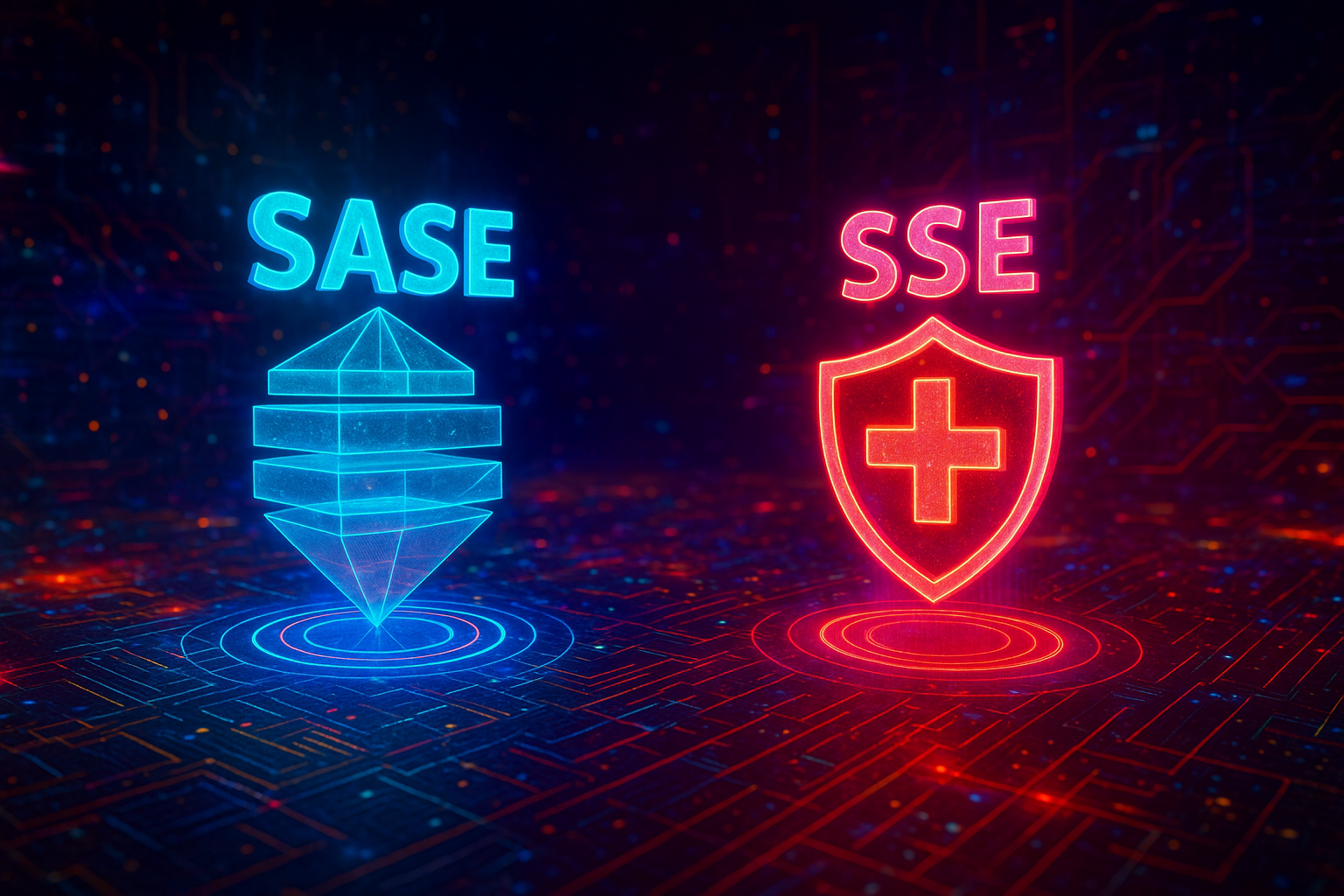SASE vs SSE. Same DNA, different body types. One’s a full-stack athlete; the other’s a surgical security specialist. If you’re in charge of making the call for your enterprise’s future architecture, this guide’s for you.
Let’s break it down into plain English, with just enough technical muscle to keep your network engineers nodding—and your CFO from panicking.
TL;DR (for the truly busy):
- SASE (Secure Access Service Edge) = Networking + Security in one cloud-native stack
- SSE (Security Service Edge) = The security half of SASE (no SD-WAN)
- Pick SSE first if your network’s solid but your security’s a dumpster fire
- Pick SASE if you’re due for both a WAN refresh and a security reboot
What is SASE, and How Is It Different from SSE?
If you’ve been reading up on edge networking trends, you’ve probably stumbled across the term “SASE” and wondered, what is SASE really—and how is it different from SSE? Great question.
SASE, coined by Gartner in 2019, stands for Secure Access Service Edge. It’s a full-stack solution that merges both networking and security in the cloud. Think SD-WAN + SSE bundled together and delivered from globally distributed Points of Presence (PoPs). SSE came later (2021) and is the security-only piece of the puzzle. It handles traffic inspection, policy enforcement, access controls—but doesn’t manage how packets are routed.
So while both aim to secure users and data in a perimeter-less world, only SASE also controls the roads data travels on. SSE is a fantastic checkpoint—but SASE builds and operates the entire highway.
SASE and SSE – The Origin Story
SASE came into the world as the cloud-native fix for the failing hub-and-spoke model. Backhauling traffic through a central data center just to apply policy made sense when apps lived in the data center too. But in a world where apps, users, and data are all scattered across the cloud, something had to change.
SASE is that change. It puts both your traffic and your security stack closer to the edge—right where your users are. SSE was introduced two years later as a modular starting point: everything security, nothing routing.
Think of it this way:
- SASE = your entire circulatory + immune system
- SSE = the immune system only
Both are cloud-native. Both enforce Zero Trust. But they differ in scope, reach, and operational impact.
Core Components: Who Has What?
Here’s a head-to-head look at the architectural makeup of each model:
Layer | SASE | SSE | Difference |
Transport fabric | Global SD-WAN, dynamic routing, QoS | — | SSE doesn’t control network paths |
Security stack | SWG, CASB, ZTNA, FWaaS, DLP, IPS | Same (minus SD-WAN logic) | Nearly identical here |
Policy engine | Context-aware: user + app + device + path | Same | The brain is the same – reach is different |
Edge POPs | 100+ PoPs acting as hubs and brokers | 100+ PoPs acting as security brokers | No WAN routing in SSE-only POPs |
Experience monitoring | Full DEM across WAN and security | DEM focused on app/SaaS experience | SASE gives more visibility end-to-end |
The Life of a Packet: Where the Rubber Meets the Road
In both models, the user/device establishes a tunnel to the nearest POP. Then:
- SASE: Encrypted traffic is routed through the SD-WAN fabric → policies applied (SWG → CASB → ZTNA) → routed directly to app, another site, or branch via optimized path.
- SSE: Encrypted traffic hits the POP → policies applied → then handed back to your MPLS or public internet route.
This matters a lot when:
- You have latency-sensitive apps (VoIP, VDI)
- You need to move traffic between branches/sites
- You’re tired of backhauling traffic to HQ just to get to Salesforce
SASE = full control. SSE = limited detour.
Cost, ROI, and Effort
Here’s where it gets real—because every transformation has a cost.
Metric | SASE | SSE |
WAN cost reduction | 30–50% | 0% (uses existing WAN) |
Hardware/appliance reduction | Up to 60% | Around 40% |
NetOps/SecOps burden | ↓45% | ↓30% |
Average payback time | <6 months | 8–12 months |
If you’re bleeding cash on MPLS or stacking boxes at every branch, SASE is the financial no-brainer.
Use Cases and Deployment Playbooks
When SSE Wins
- You’ve recently deployed or refreshed SD-WAN
- You need security transformation yesterday
- You have mostly SaaS and remote users
When SASE Wins
- Your WAN is due for an overhaul
- Your security stack is all over the place
- You want to consolidate vendors and licensing
The Hybrid Road
- Start with SSE (agents + GRE tunnels)
- Pilot SD-WAN at key branches
- Cut over to full SASE in 90–180 days
This gives you agility without forcing a rip-and-replace.
Compliance, Control & Visibility
Compliance Framework | SASE Coverage | SSE Coverage | Why It Matters |
PCI-DSS 4.0 | Tokenization for WAN + SaaS | SaaS-only tokenization | Better branch protection with SASE |
HIPAA | End-to-end DLP across sites + cloud | Cloud ePHI only | SASE secures everything, not just SaaS |
GDPR / NIS2 | Full edge telemetry & logging | Partial (internet flows only) | Audit-readiness = SASE win |
If regulators care about what flows between branches—not just what hits Salesforce—you need SASE.
Performance Benchmarks: Real Data, Not Hype
Metric | Zscaler | Cisco Secure Access | Netskope |
HTTP latency (95th %) | 76 ms | 68 ms | 82 ms |
TLS decryption throughput (Gbps) | 8.5 | 9.2 | 7.4 |
Threat-block rate | 98.7% | 99.3% | 98.5% |
SSE providers are highly performant—but their edge is security. If your concern is total path control + app QoS, SASE vendors (like Palo Alto Prisma or Cato) bring better network-layer visibility.
KPIs That Actually Matter
KPI | SASE Target | SSE Target |
Proxy/edge latency (95th %) | ≤ 100ms | ≤ 100ms |
MPLS ↘ Cost | –30–50% | n/a |
VPN trouble ticket closure | 100% | 100% |
Policy change MTTR | < 30 min | < 30 min |
Appliance count reduction | –60% | –40% |
90-Day Deployment Blueprint
Weeks 0–2:
- Baseline latency, jitter, VPN usage, and MPLS costs
- Sync with IdP (Azure AD / Okta) and begin DEM probes
Weeks 3–4:
- For SASE: Pilot SD-WAN CPE + security at one branch
- For SSE: Pilot 50 users via agent or GRE tunnel to PoP
Weeks 5–8:
- Expand to more branches; test failback
- Turn on security services in phased rollout: SWG → CASB → ZTNA
Weeks 9–12:
- Retire MPLS (SASE), decommission VPN gateways (both)
- Connect logs to SIEM, finalize reporting flows
Golden Rule: Don’t activate “block mode” on any engine until business apps run clean for 72 hours in monitor mode.
Your One-Slide Pitch to Leadership
SSE hardens security in weeks. SASE transforms networking and security together for long-term savings.
- Phase 1: Start with SSE—get off VPNs and gain visibility
- Phase 2: When contracts expire or expansion hits, evolve into SASE
Result:
- 2–4x ROI in year one
- 40–60% fewer boxes to manage
- Happier users and better sleep for your SOC team
RFP & PoC: Questions That Separate the Real from the Marketing
When it’s time to evaluate vendors, don’t settle for vague promises. These are the killer questions that will flush out who’s built a real platform—and who duct-taped together a brochure:
RFP Questions
- “List all PoPs within 250 km of our key offices. Which carrier backbones do you leverage?”
- “Provide audited 95th-percentile proxy latency from Tel Aviv → London (Jan–Mar 2025).”
- “Explain how you enforce device posture before ZTNA access—include API support for custom signals.”
- “Do you support single-pass traffic inspection (SWG + CASB + ZTNA + FWaaS) in one flow?”
- “How fast can raw logs be exported to our SIEM? Show a Splunk or QRadar integration example.”
- “Can you roll back policy changes in under 15 minutes if a pilot breaks critical apps?”
Proof-of-Concept (PoC) Triggers
- Ask for a monitored pilot where you test VoIP + Teams under load.
- Introduce a “shadow IT” SaaS app mid-test—see if it’s caught, logged, blocked, or ignored.
- Simulate identity drift (user from trusted device switches to personal laptop)—how fast is access revoked?
You’re not buying features. You’re buying confidence that this edge platform will have your back at 2am.
Future Trends: What’s Coming Next (2025–2027)
This industry doesn’t sleep—and neither should your strategy. Keep an eye on:
- SASE Peering: Vendors start peering across clouds to avoid double hair-pinning between different ecosystems.
- Post-Quantum Encryption: Kyber and Hybrid PQC suites are coming to PoPs near you.
- LLM-Aware DLP: Scanning large language model prompts/responses for sensitive data in <1 ms.
- ID-WAN (Identity-Defined WAN): Full convergence of ZTNA + SD-WAN into a QUIC-based transport.
- AI-based Threat Correlation: SSE stacks that self-prioritize alerts based on intent + behavior, not just IOCs.
Make sure your vendor is building toward this—not just reacting when it’s too late.
Final Checklist: Before You Choose
✔ Are >50% of your IT tickets security-related? You probably want to start with SSE.
✔ Do you still hairpin branch apps through HQ? Time to SASE that network.
✔ Is your MPLS contract up in <12 months? This is your moment to break free.
✔ Are compliance teams breathing down your neck? Get full-flow visibility with SASE.
✔ Need to prove ROI this quarter? SSE gives you the fastest initial win.
Final Word (Really This Time)
SASE and SSE aren’t opposites. They’re phases.
Start with SSE if you’re under pressure to secure cloud access now. Expand into SASE when the time comes to modernize your network.
Either way, stop duct-taping security onto 15-year-old WAN infrastructure. The future of secure access is converged, contextual, and cloud-native. And it’s already here.
Need help evaluating vendors? Want a full PoC script or deployment blueprint customized to your environment? I got you.
Just say the word—and we’ll make your edge strategy unbreakable.





